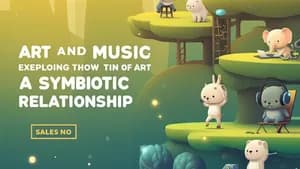Introduction: Finding Harmony in Nature
Have you ever stopped to listen to the rustling leaves in a forest, the crashing waves on a shore, or the gentle hum of a bee in a meadow? These sounds, along with the sights, smells, and textures of the natural world, have inspired artists and musicians for centuries. This article explores the profound connection between nature and creative expression, demonstrating how the natural world serves as a wellspring of inspiration for both art and music. We'll delve into specific examples and provide you with practical ways to tap into this inspiration in your own creative pursuits.
The Visual Language of Nature in Art
Artists have always sought to capture the essence of nature on canvas, in sculpture, and in various other mediums. Consider the Impressionist painters who sought to depict the fleeting effects of light and atmosphere, mirroring the transient beauty of a natural scene. Claude Monet's water lilies, for instance, aren't simply botanical studies; they are evocative expressions of the interplay of light, water, and reflection, capturing a feeling more than a photographic image. Similarly, the vibrant colors and sweeping brushstrokes of Van Gogh's sunflowers reflect the energy and life force of nature. You can apply this to your own work by paying close attention to detail when observing nature. Try sketching outdoors, focusing not only on the shapes of objects but also on the light and shadow, the texture of bark or the movement of water. Experiment with color palettes inspired by the natural world—the deep blues of a twilight sky, the fiery oranges of a sunset, or the muted greens of a forest floor.
Musical Echoes of the Natural World
Just as visual artists translate the visual aspects of nature, composers and musicians have long sought to capture its sounds and rhythms. Think of the pastoral symphonies of Beethoven or the evocative soundscapes of Debussy. The flowing melodies of Vivaldi's “Four Seasons” directly mirror the changing moods and sounds of each season. The chirping of crickets, the howling wind, the gentle lapping of water—all are translated into musical motifs and textures that evoke a specific natural environment. To enhance your musical understanding, try creating a soundscape inspired by a particular natural setting. You can use real-world sounds recorded outdoors, or you can compose melodies and rhythms that reflect the mood and energy of the setting. Experiment with different instruments and timbres to create a rich and evocative soundscape. For example, the high-pitched tones of a flute could represent a bird's song, while the low rumble of a cello might convey the sound of distant thunder.
Patterns and Structures: Nature's Geometry
Nature is abundant with intricate patterns and structures. From the spiral arrangement of sunflower seeds to the hexagonal cells of a honeycomb, mathematical principles underpin many natural phenomena. These patterns have influenced both artists and musicians. The Golden Ratio, a mathematical proportion found throughout nature, has been used in art and architecture for centuries to create aesthetically pleasing compositions. Similarly, the Fibonacci sequence, a series of numbers where each number is the sum of the two preceding ones, is reflected in many natural patterns and has influenced musical compositions through its rhythmic and melodic structures. Understanding these underlying patterns can help you create more balanced and harmonious works. For example, try analyzing the patterns in a flower or a seashell and then incorporating these principles into your own artwork or music. Look for repeating motifs, symmetry, and variations in rhythm and structure.
Integrating Nature's Inspiration into Your Learning
Connecting your artistic or musical studies with the natural world can enrich your creative process and deepen your understanding of both subjects. Make it a point to spend time in nature regularly. Keep a nature journal, sketching, painting, or writing observations about what you see, hear, and feel. Collect natural objects like leaves, stones, or feathers, and use them as inspiration for your artwork or as percussion instruments in your music. If you're struggling with a piece of artwork or composition, take a walk outdoors—the fresh air and the sights and sounds of nature can often spark new ideas and perspectives. Listening to nature-inspired music can also be very helpful in finding your inspiration. There is no right or wrong. The key is to observe, listen, and experiment.
Conclusion: A Continuing Dialogue
The relationship between nature and creative expression is ongoing, a continuous dialogue between the natural world and human imagination. By paying attention to the details of the natural world, exploring its patterns and structures, and embracing its inherent rhythms and harmonies, you can unlock a vast reservoir of inspiration for your own artistic and musical endeavors. Embrace your creative process. Nature provides an abundance of creative material for you to express yourself. The world awaits your unique expression.

